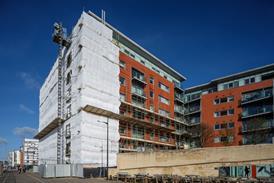Tim Champney looks at the impact of climate change in property transactions, and how new tools and products can help firms

As climate change continues to influence everything from lending decisions to insurance and planning policy, property lawyers are facing new questions around environmental risk and their responsibilities in highlighting it.
Tim Champney, director of property risk and geodata at Dye & Durham UK, answers question about what’s changing, and how recent Law Society guidance leans on new tools which are available to asses climate-related risks, helping law firms stay compliant and focused on the task at hand.
There’s a lot of talk about climate risk and property transactions right now. What’s driving the conversation?
The conversation has shifted dramatically in recent years. Climate change is no longer seen as a distant or theoretical concern in the property world; it’s now a tangible, mainstream risk which can affect everything from property values to mortgage eligibility.
Some lenders, and particularly insurers, have for some time considered environmental risks in their decision and underwriting processes. But increasingly many are looking much further down the tracks at how a property might perform against their acceptance criteria in 25 or 50 years time, in many cases using environmental climate risk data from suppliers like ourselves. Add to that the recent release of the Law Society practice note on climate change and property and you can see why this has become a hot topic.
What’s your interpretation of the Law Society’s guidance to date?
The Law Society’s 2023 guidance was a big step forward. It was broad, but it helped to normalise the discussion around climate change and highlight that all those involved in property transactions, whatever their role, could be affected. It did so by shining a light on the three key climate risk categories:
- physical risks (such as new or worsening exposure to flooding),
- transitional risks (such as changes in policy, regulation, or buyer sentiment), and
- liability risk (for instance, potential claims arising from loss suffered due to a physical or transitional risk manifesting in the future).
What’s significant is that the more property-focussed May 2025 practice note makes it clear that, for all the above reasons, solicitors have a duty to inform clients of foreseeable climate-related risks as part of the due diligence process. That’s a major shift and one that is already shaping how firms operate.
What’s the role of the conveyancer in all of this? Are they expected to advise?
Conveyancers and property solicitors are not climate experts; they’re not expected to interpret the risk data or provide technical advice. However, they do have a duty to inform clients and to advise on the potential legal implications of any such risks which are identified.
That means making clients aware of the availability of environmental searches that incorporate climate insights, like our EnviroAssure or Enviro360™ reports. It’s about signposting, and thereafter advising on the implications arising from the risks identified.
Can you tell us more about these reports – what do they include?
Absolutely. Although we’ve had climate change tools available to the legal market since early 2022, in the run up to the practice note publication we released two full environmental search products, EnviroAssure and Enviro360™, both incorporating our new ClimateCheck™ tool.
ClimateCheck™ provides a clear, future-facing summary of how environmental risks, such as flooding, ground stability, and coastal erosion, could evolve by 2050. It uses a single emissions pathway (RCP4.5), which offers a consistent, realistic outlook and helps avoid confusion or misinterpretation. It also looks at other physical risks such as heat stress, and transitional risks such as minimum energy efficiency standards.
We’ve designed the reports to present risk in a way that end clients can understand, with next steps clearly outlined, reducing pressure on the legal practitioner to translate technical or scientific information.
What’s the benefit for firms?
There are several – first and foremost, as a solicitor it helps protect your clients. They need to understand not just the current risk to a property, but how that risk may change in the years to come within the context of their intended duration of occupation or ownership, and ambitions for use during that period.
Second, it protects the firm from a regulatory, reputational, financial and operational standpoint. A firm which can readily evidence that it is taking steps to inform the end client, and discharge the clear duties set out in the guidance, is likely to be less exposed to these risks than a firm who chooses not to. As Ian Quayle, qualified solicitor and expert trainer from Property Law UK, said in a recent Dye & Durham webinar, “it would be a brave firm to ignore or fail to recommend a climate report in 2025.”
Is this really going to become standard in conveyancing?
It already is. And the uptake amongst practitioners will continue to build until only a minority of transactions progress without reference to climate-change information. We’ve seen this happen before. Many aspects of environmental risks which were considered new or niche at their introduction are now very much a routine part of the process. Climate reporting will follow the same path.
Whether you’re identifying current risk or anticipating future exposure, this information will increasingly influence buyer sentiment, lender decisions and insurance availability. It’s not going away.
Finally, what would your advice be to firms right now?
Start the conversation now. The implications of climate change extend far more broadly in the legal space than just conveyancing. But in terms of property specifically, I’d suggest researching the tools available to help you navigate the issues. Read the Law Society’s practice note. Get familiar with how reports like EnviroAssure and Enviro360™ work and how they can be integrated into your workflow. You don’t need to become a climate expert overnight, but you should have a plan to address the issue within your practice.




















